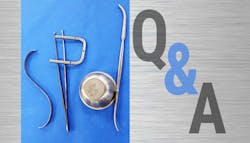Seeking storage; 9 steps to clean; processing carbide inserts
Submit your questions: email: [email protected]
Q
I work in a small rural hospital and am responsible for all supply functions as well as sterile processing. Our storage space is very limited and I was wondering if it was required to store sterile and unsterile supplies in different rooms or locations or would it be acceptable to store them together in the same room, cupboard or storage cart? The only space I have allocated for supply storage is being divided to expand one of the ORs and I will be losing approximately 50 square feet of space. Of course I contested losing the space but the OR director said that I would have to find a way to make things work because patient-needs come first.
A
The best practice would be to ensure that sterile items are stored separately from clean, unsterile supplies and equipment. Understandably, there might be circumstances where sterile and unsterile items will need to be stored in close proximity to one another or perhaps even in the same cupboard or cart. In such situations it is best to provide some identified separation between the sterile and unsterile clean supplies and equipment. It is important to provide conditions that will protect the sterile items from possible contamination or damage, which could compromise the sterile integrity and sterility maintenance of the sterile package.
Sterile items should be placed on the upper shelves and the clean supplies and equipment should be placed on the lower shelves below the sterile items to help minimize the likelihood of dust, lint or other debris from falling on the sterile items. For added protection, another option is to place the sterile items in rigid storage bins and or dust covers. Shelving should be well organized, clearly marked to identify products and the sterile storage space. This will help eliminate the unnecessary over-handling of sterile packages when looking for a needed item.
Also, sterile stock should be rotated to ensure older items are used first. Attention should also be taken to manage inventory levels avoiding overstocking situations which, not only wastes valuable space, but also increases the potential for contamination.
Q I am a CRCST Senior Team Leader in sterile processing and soon we will be taking on the responsibility for the cleaning of flexible endoscopes. In preparation of this I have attended a few workshops and seminars on the proper cleaning of scopes. I get confused as I have heard different opinions for the required steps involved in the cleaning process. I have heard there are 10, 12, 25 and other numbers up to100 steps for cleaning a scope. I don’t understand how there can be such a large gap in what people are saying is required to clean a scope. I would think there would be one right way to do this.
A
I can understand your confusion. It all starts with precisely following all of the manufacturer’s instructions for use (IFU), which includes the manufacturer of:
- The medical device
- All processing equipment, AER, washers, disinfectors
- All utensils and cleaning accessories
- Chemical and cleaning agents
As for the number of steps in the process, SGNA (Society of Gastroenterology Nurses and Associates) identifies the following nine essential functions (often referred to as steps) required in the cleaning process of a flexible endoscope:
- Precleaning
- Leak testing
- Manual cleaning
- Rinse after cleaning
- Visual inspection (includes cleaning verification)
- High-level disinfection (manual or automated)
- Rinse after high level disinfection
- Drying (alcohol and forced air)
- Storage
Each one of these functions, to be effective, has multiple procedural steps which when combined would very easily amount to more than 100. But you don’t need to get hung up on the numbers you hear quoted – just follow all IFUs and the procedural sequence of events to attain quality outcomes.
Q I recently attended a seminar on cleaning surgical instruments and the presenter reviewed the various cleaning tools that should be used, such as brushes, spray guns, magnifiers, etc. They also reviewed the use of washer disinfectors, cart washers, AERs and ultra-sonics. I was surprised and puzzled when she said that instruments with carbide inserts could not be processed in an ultra -sonic washer. We always run our needle holders with inserts through the ultrasonic and have had no known problems. Should we not be doing this?
AThis question comes up frequently. I have consulted with several instrument manufacturers and repair companies. They all stated that the carbide insert needle holders can be washed in the ultra-sonic, assuming the hospital is using a validated process and cleaning products. You should always obtain and follow the specific instrument manufacturer’s IFU for the care and handling of their individual instruments and other medical devices.
The carbide inserts, after normal wear and tear, will need to be replaced. It is very important that you use a reputable and qualified instrument repair company. As is the case with all surgical instrumentation, it is wise to have a preventative maintenance program in place where all instruments receive routine professional inspection and appropriate servicing. When the inserts are replaced, they are secured with silver-copper-tin-zinc alloy that forms a strong bond between the insert and instrument jaw. In extreme cases, if corrosive cleaning agents such as strong oxidizers and those with a high acid base are utilized over time, they will cause pitting that can affect silver solder and any aggressive cleaning and mechanical action including ultrasonic could loosen the insert. Follow manufacturers IFUs and utilize the appropriate chemical cleaning agents and there should be no problem processing carbide insert instruments in the ultrasonic.
About the Author

Ray Taurasi
Ray Taurasi is Principal, Healthcare CS Solutions. His healthcare career spans over five decades as an Administrator, Educator, Technologist and Consultant. He is a member of AORN, SGNA, AAMI and a past president of IAHCSMM. Taurasi has been a faculty member of numerous colleges teaching in the divisions of business administration, nursing, and health sciences. He is the author of numerous articles and textbook chapters; he is a frequent speaker at national and international healthcare conferences.
Note to readers from Ray Taurasi - In 2021, my life’s career path will transition to one of new opportunities and adventures. As a result, after nearly 19 years and 225 CS Solution columns, this edition will be my last.
“All changes, even the most longed for, have their melancholy; for what we leave behind us is a part of ourselves; we must die to one life before we can enter another.”– Anatole France
I wish you and your loved ones a healthy and joyful holiday season and a beautiful New Year! God Speed, Ray
https://www.facebook.com/pages/category/ Local-Business/Healthcare-CS-Solutions-128857 3061153887/ • email: [email protected]
